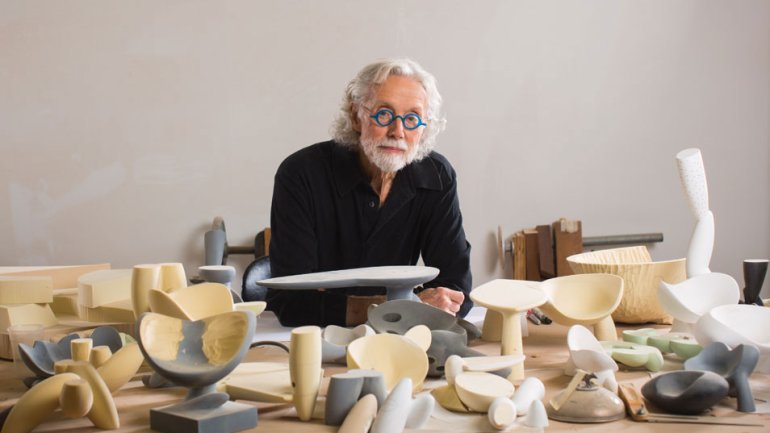Remembering: Wendell Castle
Furniture was furniture, and sculpture was sculpture, more or less, until Wendell Castle came along. Castle, who died January 20 at his home in Scottsville, New York, at 85, didn’t just blur the boundary between the two. He sawed through it, freeing himself to create elegant, often humorous tables, chairs, desks, and other objects whose functionality is matched (and sometimes exceeded) by their beauty as pure sculpture.
Castle’s innovative, exquisitely crafted work, found in museums and collections around the world, and ceaseless creative inquiry earned him the moniker “father of the art furniture movement,” along with awards, prizes, and honors throughout his 55-year career: four honorary doctorates; a Visionary Award from the Smithsonian and a Leadership Medal from its Renwick Gallery; and an ACC Gold Medal, to name just a few. He was a revered teacher, mentor, and artist in residence at the Rochester Institute of Technology, where until recently he continued to teach graduate seminars.
Castle’s early life held few hints of such future trailblazing success. Born November 6, 1932, in Emporia, Kansas, he scraped through school, hampered by undiagnosed dyslexia. “I was good at daydreaming,” Castle said. He loved to draw, but had little formal exposure to art until college, where a professor spotted his talent.
Castle earned a BFA in industrial design and an MFA in sculpture from the University of Kansas, then moved to Rochester, New York, in 1962 to teach woodworking and furniture design at RIT. Not long after, he turned to making sculptural furniture.
“I saw an opportunity,” he recalled to American Craft in 2008. “I could see that to make it as a sculptor was a tough road. There were an awful lot of people doing that. Then I saw this other thing that nobody was doing, virtually nobody. I thought here is something I can try at no risk, because if it didn’t work out, I could go back to making sculpture.”
In 1964, Castle, at the prompting of Jack Lenor Larsen, showed his Music Rack at the Milan triennial. Formed of just a few perfectly placed strokes, like Zen calligraphy in wood, the piece took the art world by storm and vaulted Castle to the top of a brand-new field. There he stayed for more than half a century.
The music stand also showed off a technique Castle pioneered, after borrowing the basics from an article on duck decoy construction: sliced, stacked, glued, clamped, and laminated wood. The infinite flexibility of this method permitted Castle to realize in wood any form he could daydream up, while his lifelong habit of drawing helped him capture and refine those dreams.
The artist, whom friends described as thoughtful and soft-spoken, remained engaged in producing new work until his death. He never stopped poking at the far edges of the possible. While shunning computer renderings – “the computer wants to iron out your lumps and bumps, and I don’t want them ironed out” – he embraced technology to help bring his ideas to life. For a 2015 show at the Museum of Arts and Design, “Wendell Castle Remastered,” early works inspired new ones he created with the aid of 3D scanning and modeling and computer-aided milling.
Besides his prolific artistic career, Castle led a full life outside the studio, enjoying tennis, sports cars, singing, playing guitar, dogs, and time with his beloved family: his wife, Nancy Jurs, daughter, Alison, stepson, Bryon, and grandchildren, Arabella and Archibald.
In 1996, Castle published “Adopted Rules of Thumb,” his personal guide to creativity, which quickly caught on among other artists; he updated it on the occasion of his 80th birthday in 2012.
The Original 10 Adopted Rules of Thumb
- If you are in love with an idea, you are no judge of its beauty or value.
- It is difficult to see the whole picture when you are inside the frame.
- After learning the tricks of the trade, don’t think you know the trade.
- We hear and apprehend what we already know.
- The dog that stays on the porch will find no bones.
- Never state a problem to yourself in the same terms it was brought to you.
- If it’s offbeat or surprising it’s probably useful.
- If you do not expect the unexpected, you will not find it.
- Don’t get too serious.
- If you hit the bull’s-eye every time, the target is too near.
New Adopted Rules of Thumb
- Distrust what comes easily.
- You have to stand for something, or you’ll fall for anything.
- Bring conflicting attitudes to bear on the same problem.
- We should never know for whom you’re designing.
- Always listen to the voice of eccentricity.
- The whole secret to designing a chair is applying the seat of your pants to the seat of the chair.
- The problem with taking life in your own hands is you have no one else to blame.
- If your mind is not baffled, your mind is not fully employed.
- Imagination, not reason, creates what is novel.
- Jumping to conclusions is not exercise.
- Keep knocking – eventually someone will look down to see who’s there.




